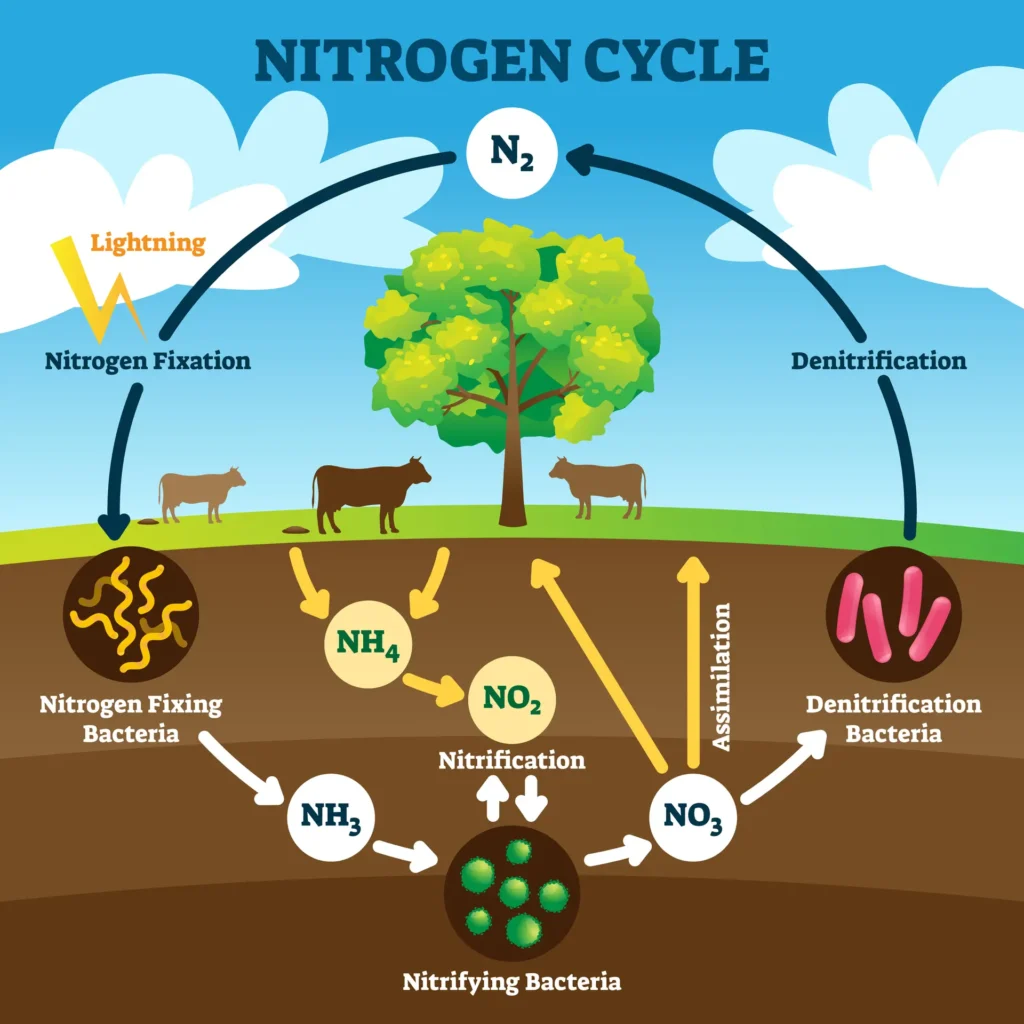The Nitrogen Cycle
The nitrogen cycle is a crucial process that moves nitrogen through the atmosphere, soil, plants, animals, and microorganisms. Nitrogen is an essential element for all living organisms because it is a key component of proteins, DNA, and other vital molecules. Despite its abundance in the atmosphere, nitrogen cannot be used directly by most organisms and must undergo a series of transformations to become usable. Understanding the nitrogen cycle helps explain how ecosystems maintain balance and how human activities can impact this process.
Stages of the Nitrogen Cycle
- Nitrogen Fixation
- The nitrogen cycle begins with nitrogen fixation, where atmospheric nitrogen (N2) converts into a form plants can use, typically ammonia (NH3) or ammonium (NH4+). Nitrogen-fixing bacteria, such as Rhizobium, primarily carry out this process in the root nodules of leguminous plants like beans and peas. Natural events like lightning and industrial processes, such as the Haber-Bosch method for producing fertilizers, also contribute to nitrogen fixation.
- 4o
- Nitrification
In nitrification, nitrifying bacteria transform ammonia into nitrites (NO2-) and then into nitrates (NO3-). Plants easily absorb these nitrates and use them to synthesize proteins and other essential compounds. Two types of bacteria drive this process: - Nitrosomonas bacteria convert ammonia into nitrites.
- Nitrobacter bacteria convert nitrites into nitrates.
- Assimilation
- Assimilation begins when plants take up nitrates from the soil. They then incorporate these nitrates into organic molecules, such as amino acids, proteins, and nucleic acids. Additionally, when animals consume these plants, they assimilate nitrogen in the form of proteins and other compounds. These compounds are essential for their growth and survival.
- Ammonification
- When plants and animals die, decomposer organisms, such as bacteria and fungi, begin to break down their bodies. As a result, the nitrogen within their tissues is returned to the soil in the form of ammonia. This process, known as ammonification, plays a vital role in the nitrogen cycle. It recycles nitrogen back into the soil, ensuring that it remains available for plants to use once again.
- Denitrification
- Denitrification is the final step in the nitrogen cycle, where nitrates in the soil are converted back into nitrogen gas (N2) by denitrifying bacteria, such as Pseudomonas and Clostridium. These bacteria thrive in low-oxygen environments, such as waterlogged soils. Denitrification helps balance the nitrogen cycle by returning nitrogen to the atmosphere, completing the cycle.
Importance of the Nitrogen Cycle
The nitrogen cycle is vital for sustaining life on Earth. Nitrogen is a fundamental building block of amino acids, proteins, and nucleic acids, which are necessary for the growth and reproduction of all living organisms. By converting nitrogen into forms that plants and animals can use, the nitrogen cycle ensures that ecosystems remain productive and balanced.
In agriculture, understanding the nitrogen cycle is crucial for managing soil fertility. Farmers use nitrogen-based fertilizers to replenish the soil, ensuring that crops receive the nutrients they need to grow. However, excessive use of synthetic fertilizers can disrupt the nitrogen cycle, leading to issues such as water pollution and the release of nitrous oxide, a potent greenhouse gas.
Human Impact on Ecosystems
Human activities, particularly industrial agriculture and the burning of fossil fuels, have significantly altered the nitrogen cycle. The widespread use of nitrogen-based fertilizers has increased the amount of nitrogen in the soil, leading to nutrient imbalances and water pollution. Eutrophication, caused by excess nitrogen runoff into bodies of water, can result in harmful algal blooms and dead zones, where aquatic life cannot survive.
Additionally, the burning of fossil fuels releases nitrogen oxides into the atmosphere, contributing to air pollution and acid rain. These changes can disrupt ecosystems and negatively impact biodiversity, highlighting the importance of sustainable practices to protect the nitrogen cycle.
